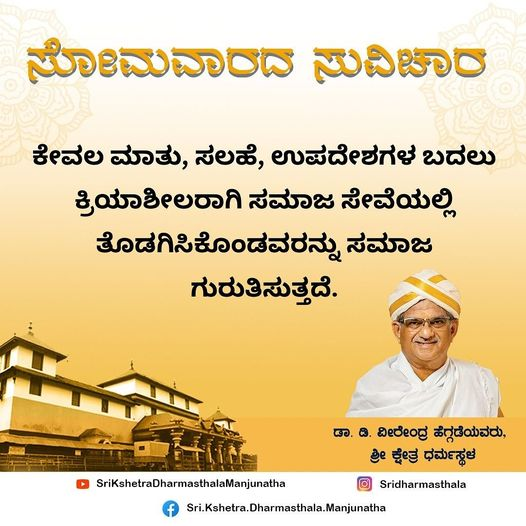About Dharmasthala
Home / History

800 years ago, Dharmasthala was known as Kuduma in Mallarmadi, a then village in South Kanara. Here lived the Jain Chieftain Birmanna Pergade and his wife Ammu Ballalthi in a house called Nelyadi Beedu. Simple, pious and affectionate people; the Pergade family was known for its generosity and hospitality to all.
According to legend, the guardian angels of Dharma assumed human forms and arrived at Pergade’s abode in search of a place where Dharma was being practiced and could be continued and propagated. As was their habit, the Pergade couple hosted these illustrious visitors with all their wherewithal and great respect. Pleased by their sincerity and generosity, that night the Dharma Daivas appeared in the dreams of Shri Birmanna Pergade. They explained the purpose of their visit to him and instructed him to vacate his house for the worship of the Daivas and dedicate his life to the propagation of Dharma.
Asking no questions, the Pergade built himself another house and began worshipping the Daivas at Nelyadi Beedu. This continues even today.
As they continued their worship and their practice of hospitality, the Dharma Daivas again appeared before Shri Birmanna Pergade to build separate shrines dedicated to the four Dharma Daivas – Kalarahu, Kalarkai, Kumaraswamy and Kanyakumari. Also, Pergade was instructed to choose two persons of noble birth to act as the Daivas’ oracles and four worthy persons to assist Shri Pergade in his duties as the Executive Head of the shrines. In return, the Daivas promised Shri Pergade family protection, abundance of charity and renown for the ‘Shri Kshetra’.
As ordained, Shri Pergade built the shrines and invited Brahmin priests to perform the rituals. These priests requested Pergade to also install a Shivlinga beside the native Daivas. The Daivas then sent their vassal Annappa Swamy to procure the Idol of Lord Manjunatheshwara from Kadri, near Mangalore. Subsequently Shree Manjunatha Swamy temple was built around this idol.
Around the 16 Century, Shri Devaraja Heggade invited Shri Vadiraja Swami of Udupi to visit the shrine. The Swamiji gladly came but refused to accept Bhiksha (food offering) because the idol of Lord Manjunatha had not been consecrated according to the vedic rites. Shri Heggade then requested the Swamiji to re-consecrate the shiva linga himself. Pleased by the observance of the vedic rites and Heggade’s charity to all, the Swamiji named the place Dharmasthala the abode of religion and charity. Thus, the roots of charity and religious tolerance established by the Pergades 800 years ago have been nurtured and strengthened by twenty one generations of the Heggade family, (Heggade being a derivative from Pergade). Today’s Dharmasthala blossoms with the fruit of this selfless dedication.
CONTACT US
TEMPLE OFFICE :
SHREE KSHETRA DHARMASTHALA
D.K, Karnataka -574216
Helpline : 08256 -266666
Office : 08256 – 266655
E – Mail : [email protected]
OFFICE TIMINGS :
Morning : 09:30 AM to 2 : PM
Evening : 4 PM to 9 : PM
Quick Links
© 2024 Dharmasthala. All Rights Reserved.

